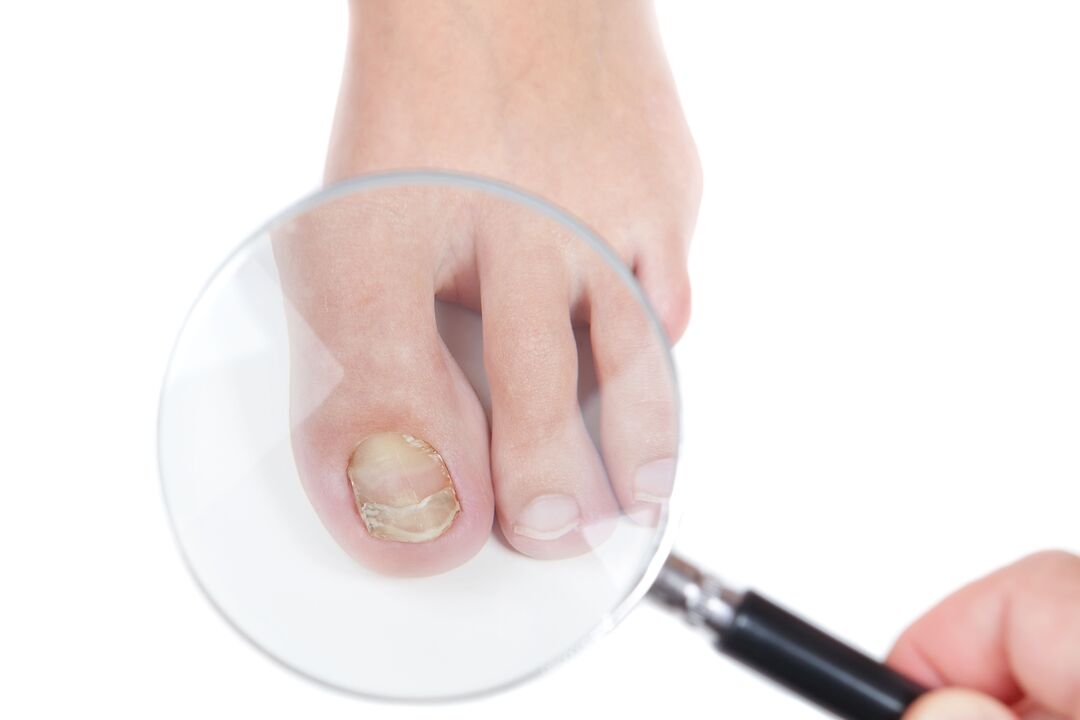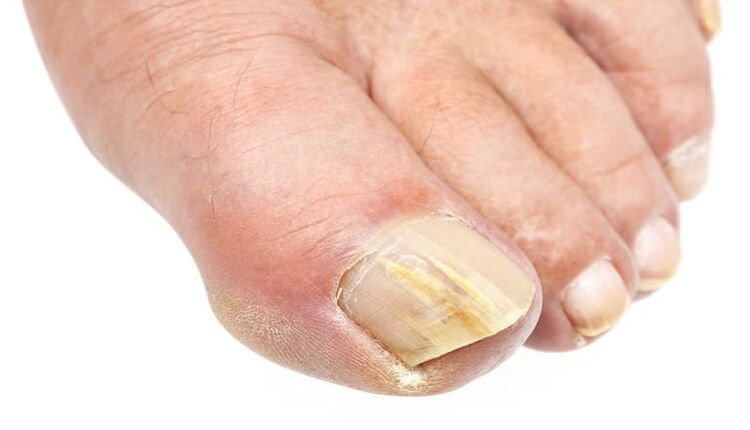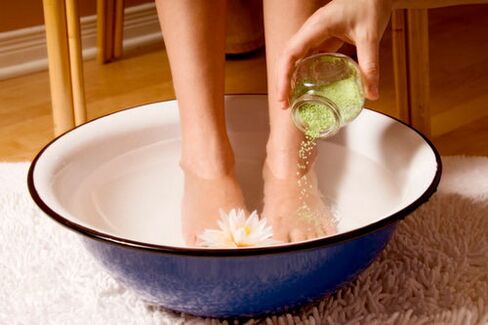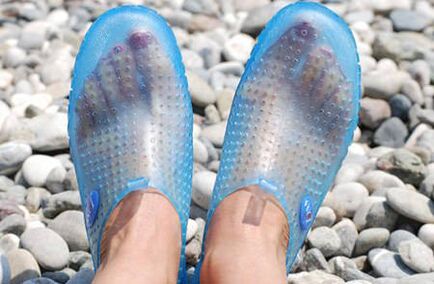Onychomycosis is a disease that gets infected very quickly but is more difficult to cure. It is not only a cosmetic problem, but also causes unpleasant and painful feelings. According to statistics, one out of every 10 residents on the planet suffers from this disease, and you may also be in a dangerous zone. What are the causes of the disease, the factors for the development of onychomycosis and how to defeat the fungus on the toenails?
How and why does toenail fungus appear?
This disease is caused by dermatophytes, yeasts and molds. According to statistics, 10 out of every 10 people on the planet are affected by this disease.

Where can you get toenail fungus? The main risk areas are swimming pools, bathrooms, and saunas. You may become infected by using other people's shoes, socks, or during pedicure. Onychomycosis is more common in patients with chronic diseases, such as obesity, diabetes, anemia, gastrointestinal tract, hormones, immune and cardiovascular diseases, and long-term steroid, antibacterial and chemotherapy treatments.
Warmth and humidity help the development of spores. The main route of infection is wounds, microcracks and other skin lesions in the finger area. Mycosis occurs when the nail plate is damaged-if we cut it short or break it, the fungus can easily penetrate the inside. Wearing tight shoes can also weaken the fabric, as do nail polish, gel and polish.
We make a diagnosis
The visual manifestation of the disease is already the second stage of the disease. The first evidence of infection-itching, burning, is usually attributed to excessive dryness of the skin, poor soap quality, and side effects of taking medications. Diagnosing and starting treatment in time will allow you to get rid of the problem quickly and effectively.
How to diagnose the disease yourself
The main symptoms are external changes, especially in the early stages of disease development. The first sign usually appears on the free edge (front) or side of the nail plate. When onychomycosis occurs, unpleasant sensations may occur during physical activity. The patient described paresthesias (numbness), pain, discomfort, and unhealthy. Typical external changes include the following symptoms:
- Discoloration-white, yellow, brown, green, gray spots appear on the end of the nail;
- The peeling and delamination of the fabric, its brittleness is obviously enhanced;
- Symptoms of thickening of the stratum corneum and hyperkeratosis;
- Unpleasant foot odor.

Fungal infections on the legs are more common than on the hands. They can be limited to one finger or cover all fingers. However, since the shoes are the closest, the disease usually affects the first and fifth toes of the foot.
How to diagnose fungus in a medical clinic
Self-diagnostic methods are not always effective because there are many diseases with a history similar to fungal infections. These include:
- Psoriasis-it may look similar, but the characteristic of this disease is that it affects symmetry. Typical signs are white spots, red holes, thimble syndrome (dents), loss of luster, and roughness due to air accumulation. In addition, the patient has typical skin lesions.
- Candidiasis. It is characterized by the appearance of purulent discharge and pain when pressing on the affected area. This disease is more common among women, especially those who often have to wear airtight, airtight shoes in hot and humid environments. To develop this type, it is necessary to injure the finger in the nail area. Leakage: The hair follicles of the plate swell and become very red and painful.
- Nutritional changes caused by mechanical damage. The problem is usually concentrated in the proximal part of the plate (ie its bottom).
- Lichen. It is characterized by typical lesions on the skin and mucous membranes. The leaves affected by lichen are usually covered with yellow-white stripes.
In addition, there are different types and forms of nail fungus, depending on the pathogen causing the problem and the duration of the infection. The clinic determines the type of disease and prescribes a treatment plan based on the tests performed.
treatment method
Treatment of onychomycosis should be started immediately after the problem is discovered. If you delay treatment, complications may occur: adjacent finger infections, conversion to chronic diseases, and progressive course of the disease. Therefore, if you find any suspicious changes or use time-tested folk methods, be sure to make an appointment with your doctor.
Folk remedies for fungi

In the early stages of the disease, home remedies can fight fungal infections well. To get rid of the fungus, you can try the following recipes:
- Tea tree oil. The mixture is a powerful natural preservative and bactericide. Apply it dropwise to the affected area twice a day. The duration of the course is 21 days.
- Apple cider vinegar. Prepare a foot bath from it and mix it with equal parts of water.
- Iodine from fungi. An ancient proven method to remove nail fungus. Usage: Once a day, apply 1-2 drops of the composition to the affected board. To prevent infection of neighboring fingers, it is recommended to lubricate them with iodine, but less frequently-once every 2-3 days.
- Listerine mouthwash. Its ingredients contain preservatives and a small amount of alcohol, which will adversely affect the treatment process.
- Lemon juice. It is applied in the form of a compress for 30 minutes. To the affected area.
Restricting food during treatment can have a positive effect. The daily diet should exclude sweets and starchy foods, increase protein (beef, fish, poultry), dairy products (yogurt, kefir, cottage cheese) intake. Fruits should also be unsweetened (lemon, grapefruit, sour apples, raspberries, cherries). Diet is necessary to enhance human immunity and reduce the concentration of fungal nutrient media-simple sugars formed in the body when eating easily digestible carbohydrates.
Modern drugs and procedures
Unfortunately, home remedies for fungal infections are usually ineffective. This is because the disease has developed into a progressive form. To get rid of it, you need to see a doctor. The effectiveness of medication depends on the duration of the course of treatment, and it can take several months even after the visual symptoms are eliminated. But patients forget that they need to continue the treatment after the cosmetic effect occurs. This can lead to relapse and need treatment from the beginning.
In the early days, when the tissue changes are small, fungicidal ointments can be very helpful. For advanced cases, oral medications are usually prescribed. Foot fungus can easily recur, so please follow your doctor's advice after recovery. Generally speaking, the duration and sequence depend on the type of infected nail, the clinical course, the number of infected nails and the degree of damage to the steel plate. In some cases, a systematic approach combining multiple methods is required. The combination of systemic exposure and local exposure improves the effectiveness of the treatment.
Topical antifungal ointment
Only when the disease occupies less than half of the distal end of the plate, and when the patient cannot tolerate systemic therapy, topical drugs should be used. Ointments and suspensions include amorolfine, ciclopirox, bifonazole, and urea. They are used daily for 5-12 months. The last option for topical treatment of onychomycosis is bifonazole in combination with a 40% urea solution.
But external drugs cannot help complete healing because they cannot penetrate the tissue sufficiently. It has been found that although the latest generation of ointments can capture all layers, their efficacy is still low when used as a single formulation. However, these drugs can be used as adjuvant therapy, supplementing oral medications, or preventing recurrence in patients who have previously taken oral medications.
Antifungal pills
Oral treatment of ringworm is almost always necessary. A new generation of antifungal drugs such as itraconazole or terbinafine have recently replaced older generic drugs in nail treatment. The effectiveness of these funds can be explained by their ability to penetrate the nail plate in just a few days after the start of the course. By using them, you can afford shorter treatment time, faster recovery speed and fewer side effects. Terbinafine (international name, you should look for commercial analogues in pharmacies), fungicides (kill pathogens) to cure the disease and prevent the subsequent spread of spores. These drugs work on both yeast viruses and dermatophytes, which are the most common causes of nail fungus.
Surgical treatment of onychomycosis
This method can also be used to treat fungal nail infections. It is mechanical and chemical removal of infected nail plates (using 40-50% urea). This is a painless and beneficial method when the growth is very thick and interferes with the comfort of the patient.
For patients receiving oral medications, removal of the nail plate of onychomycosis should be considered as an adjuvant treatment. The combination of oral, topical (lubrication) and surgical treatment of fungus provides the fastest cure rate and is also the cheapest option (least recurrence and short course of treatment).
Laser Treatment
A new method that shows the highest efficiency. Only 4 times of "cold" laser irradiation can completely get rid of the problem. The only disadvantage of this type of exposure is the relatively high cost of surgery.
Precautionary principle

After finding out the cause of the fungus on the feet, it is easier to avoid the disease. By following simple suggestions, you can prevent problems. Basic rules to avoid fungus:
- Avoid trauma to the skin around the toes.
- Don't break the edges, but only cut them off with sharp scissors.
- Only use your own towels and personal hygiene products (scissors, sandpaper and wooden sticks).
- After washing your feet, dry the skin between your toes thoroughly.
- Don't go barefoot in public places.
- Wear cotton socks and breathable shoes.
- If you sweat too much, change your socks and shoes frequently.
- Use pedicure services in a trusted location to disinfect and sterilize instruments according to established protocols.
- Do not use shoes or slippers that others have worn before.
You must take care of your feet and keep them clean. After bathing, it is recommended to treat the skin with antiseptic cosmetics. Wet shoes, after wearing them for a day, must be dried to a completely dry state-even slightly damp shoes should not be worn. Despite the precautions taken, you should consult a doctor immediately if there is any change in the characteristics of the disease.
























